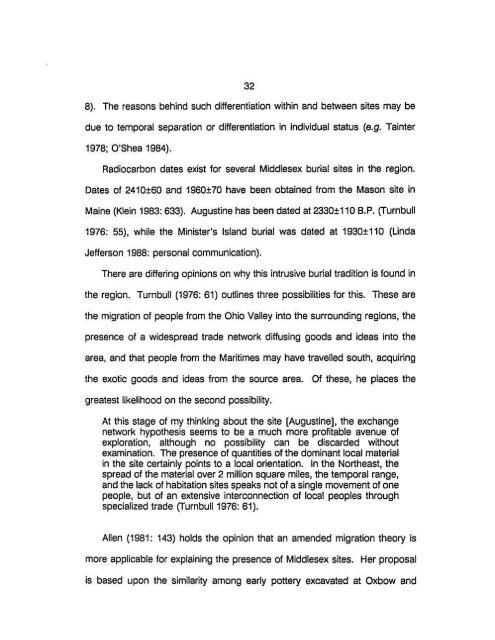CI[)l1:721 - Memorial University of Newfoundland DAI
CI[)l1:721 - Memorial University of Newfoundland DAI
CI[)l1:721 - Memorial University of Newfoundland DAI
You also want an ePaper? Increase the reach of your titles
YUMPU automatically turns print PDFs into web optimized ePapers that Google loves.
32<br />
8). The reasons behind such differentiation within and between sites may be<br />
due to temporal separation or differentiation in Individual status (e.g. Tainter<br />
1978; O'Shea 1984).<br />
Radiocarbon dates exist for several Middlesex burial siles in the region.<br />
Dates 01 2410±60 and 1960±70 have been obtained from the Mason site in<br />
Maine (Klein 1983: 633). Augustine has been dated at mO±tl0 B.P. (Turnbull<br />
1976: 55), while the Minister's Island burial was dated at 1930±110 (Unda<br />
Jefferson 1988: personal communication).<br />
There are differing opinions on why this intrusive burial tradition is found in<br />
the region. Turnbull (1976: 61) outlines three possibilities for this. These are<br />
the migration 01 people from the Ohio Valley into the surrounding regions, the<br />
presence <strong>of</strong> a widespread trade network diffusing goods and ideas into the<br />
area, and that people from the Maritimes may have travelled south, acquiring<br />
the exotic goods and ideas from the source area. Of these, he places the<br />
greatest likelihood on the second possibility.<br />
At this stage <strong>of</strong> my thinking about the site (Augustine], the exchange<br />
network hypothesis seems to be a much more pr<strong>of</strong>itable avenue <strong>of</strong><br />
exploration, although no possibility can be discarded without<br />
examination. The presence <strong>of</strong> quantities <strong>of</strong> the dominant local material<br />
in the site certainly points to a local orientation. In the Northeast, the<br />
spread <strong>of</strong> the material over 2 million square miles, the temporal range,<br />
and the lack <strong>of</strong> habitation sites speaks not <strong>of</strong> a single movement <strong>of</strong> one<br />
people, but <strong>of</strong> an extensive interconnection <strong>of</strong> local peoples through<br />
specialized trade rrurnbull 1976: 61).<br />
Allen (1981: 143) holds the opinion that an amended migration theory is<br />
more applicable for explaining the presence <strong>of</strong> Middlesex sites. Her proposal<br />
is based upon the similarity among early pottery excavated at Oxbow and

















